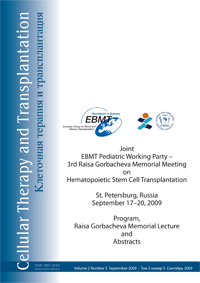Selection of optimal cryopreservation strategy for hematopoietic stem cells
Leonid I. Savelyev1,2,3, Yulia A. Yakovleva1, Grigory A. Tsaur1,2, Tatyana Yu. Verzbitskaya1,2, Alexander M. Popov1,2,3, Andrey A. Igumenshev1,2, Larisa V. Vakhonina1,2, Igor N. Vyatkin1,2, Egor V. Shorikov1,2, Larisa G. Fechina1,2
1Regional Children’s Hospital №1, Yekaterinburg, Russia; 2Research Institute of Medical Cells Technologies, Yekaterinburg, Russia;
3Ural State Medical Academy, Yekaterinburg, Russia
Summary
Background
The results of hematopoietic stem cell (HSC) transplantation depend primarily on transplant quality. The temperature compensation provided during controlled rate preservation for the release of latent heat results in improved post-cryopreservation cell viability. The major variables involved are the rate of chamber temperature decrease, hold temperature and duration, the rate of temperature increase, and the temperature at which chamber cooling is reinitiated.
Aim
To create – on the basis of international recommendations – an optimal program of freezing for HSC using cryoprotective compounds – available in Russia – and the IceCube 15M programmed freezer.
Methods
Peripheral blood mononuclear cells (PBMC) were used as a test model. The cryoprotective solution contained high–molecular weight dextran, autologous serum, and DMSO with a final concentration of 1.6%, 5%, and 10%, respectively. Results were estimated by the shape of freezing curves and cells’ viability with 7-AAD staining on FacsCanto II.
We tested 2 different volumes (185 ml and 100 ml) of PBMC. After adjusting freezing programs to the selected volume, the 2 different freezing curves gave optimal results. Afterwards created programs were used for the programmed freezing of patients’ HSC (24 samples). Thirteen samples were thawed for autologous transplantation. The median viability of HSC after thawing was 94% (range 77.5–98.9%) and the median time to hematopoietic recovery was 10 days (range 9–13).
Conclusion
It was shown that various volumes of PBMC/HSC need different freezing conditions. Thus, 2 different freezing curves were constructed for volumes less than 100 ml and more than 100 ml, respectively, that gave optimal results when assessed by viability and time to hematopoietic recovery (“take”).
Keywords
hematopoietic stem cells, cryopreservation, program of freezing, transplantation


